Marian Art ~ How Does the Artist see Our Lady
In Defense of my Choice
Last week I wrote an article about what I called the First Mother’s Day. As always, I included a feature image. I was harshly criticized for having chosen this particular image. In fact, the person who made the comment wrote that I have no understanding of Our Lady’s holiness. Initially, I felt that I should practice humility and not respond. However, after thinking more about it, I concluded that my love, understanding and relationship with Our Lady had been questioned and I felt that from the perspective of my devotion to Mary, I should defend my choice.
The Feature Image
The image I chose for this article was painted in 1880 by Alice Mary Havers, a Pre-Raphaelite artist who was, in fact, Catholic. The title of the painting is, “Mary kept all these things and pondered them in her heart.” This title was taken from the Gospel of Luke (Luke 2:19). So, you can see that there was no irreverence in this choice. The painting was done in typical Pre-Raphaelite style which is to portray beauty in a more realistic and romantic manner rather than the Academic style painting that preceded it. The history, as I see it, is unimportant in this particular matter. What is important are the artists and the ways in which they saw Our Lady.
Visualizing Mary
We all have an image of Mary which we hold dear to our hearts. After all, she is our heavenly mother; the mother who leads us to her Son. Although we don’t worship Mary, we honor and love her. The image we hold has been formed by something; perhaps a painting, a hymn, one of her many titles, or just the way we feel she looked. We often hold onto this image as we pray for her intercession because it brings us comfort or encouragement, a sense of protection and motherly love. Is your image of her the same as mine? Probably not. There are some beautiful paintings of Our Lady where she is portrayed as Asian or African. Mary is universal so this makes sense.
Artists who Paint Mary
For centuries, artists have been creating paintings, sculptures and music in honor of Mary. From Romanesque to modern, Our Lady has always been a favorite subject. Some artist painted her with reverence and others, just for pay. During the Middle Ages, the Catholic Church’s influence on art was major. It was crucial that art have symbols relating to the Church and not even a brush stroke that could have been accused of coming from the hands of a pagan artist. Without getting into the history of the Church’s influence on art, let’s take a look at two famous artists and their reverence (or not) for their subjects.
Our Lady of Perpetual Help
The famous icon, titled Our Lady of Perpetual Help, is believed by many to have been painted by Saint Luke. Of course, we don’t know this as fact but we do know that Saint Luke was an artist so the possibility is strong. If he, in fact, did paint this icon, I think it is safe to assume that the work came from love.
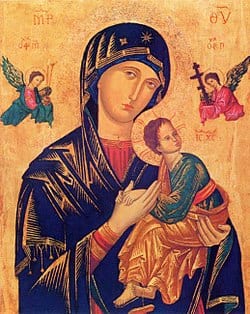
Raphael ~ Sistine Madonna
From 1513 to 1514, Italian Renaissance master, Raphael Stanza, painted one of his most famous paintings, the Sistine Madonna. This painting was commissioned by Pope Julius II as the altarpiece for the church of San Sisto, Piacenza. Raphael’s Madonnas are among the most famous in history. Seeing his works, one would think that the artist actually knew Our Lady; that he sat at her feet and prayed with her. Portrayed with exquisite beauty and grace, each piece is a tribute to her holiness and interior beauty. Raphael must have been a prayerful man with a deep devotion to her. Seeing his work, you would assume this but he, in fact, lived his life in a way that was quite contrary to Mary’s holiness. Raphael used a model for his paintings. In at least six of his Madonna paintings, the model was Margherita Luti; his mistress. Raphael Stanza died at the young age of 37. The cause of his death was a fever triggered by a long night of extreme sex with Margherita Luti. Although it is said that he was a gentle and charitable man, he was not the holy man who we would have expected to paint these glorious works of the most blessed woman who ever walked the earth.
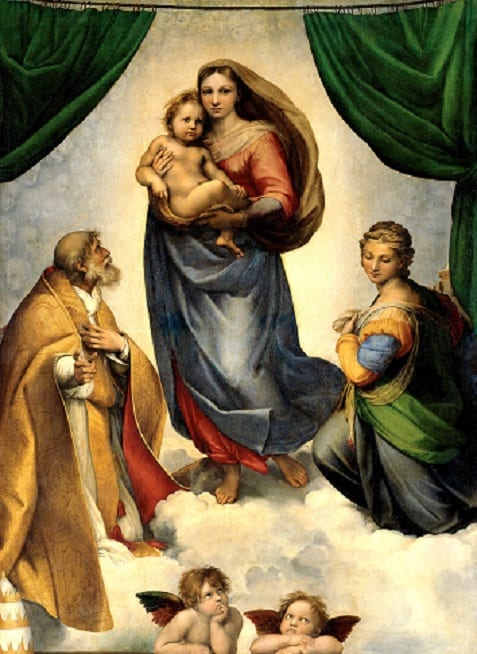
Fra Angelico
“He who wishes to paint Christ’s story must live with Christ.” ~Fra Angelico~
Fra Angelico, born in 1395, was an Early Renaissance Italian painter. Giorgio Vasari, an artist and art historian (1511-1574) described Fra Angelico as having “a rare and perfect talent”. A Dominican friar, his life was totally God focused. The rules of his order dictated that friars cared for the poor and Fra Angelico did this with love, humility and a sense of humor. All his paintings were of divine subjects. It is said that, once he began a painting, he never changed or retouched it because he believed them to be inspired by God and, in that, could not be improved. Fra Angelico is most famous for his angel paintings and his paintings of the Annunciation. He painted a number of Annunciation scenes but his most beautiful is a panel painting dating from 1432-1434, that can be seen at the Museo Diocesano in Cortona. In this painting, both the angel Gabriel and Our Lady have their arms folded over their chests in the sign of the cross. With reverence, typical of this artist, the words spoken by the angel, (“The Holy Spirit shall come upon thee, and the power of the Highest shall overshadow thee”) and Mary’s response (“Behold the handmaid of the Lord. Be it done unto me according to thy word”), are included in the painting. Mary is always portrayed with a gentility and simplicity which give a sense of love and respect for her. In 1982, Pope John Paul II proclaimed his beatification in recognition of the holiness of his life. In this, the title of “Blessed” became official. Comparing Fra Angelico to Raphael, you can see the difference in the lives of the two men, yet you would not know of these differences by viewing the magnificent art.
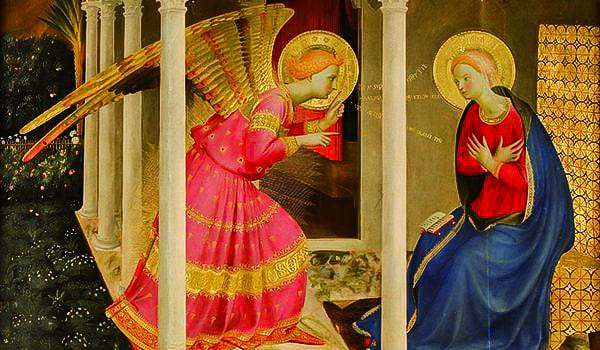
In Conclusion
Unless we are able to crawl into the mind, heart and soul of an artist, we cannot come to a conclusion about his/her reverence for Our Lady. Raphael may have had a deep devotion to Mary but lived in a contrary manner, because he had inner demons which could not be overcome. We don’t know this and we have no right to judge him. We really have no right to judge his work. We have a right to like or dislike it but not to judge it from the perspective of whether or not the artist lived a sanctified life. In Catholic art, there is often much symbolism of which we are not aware. We don’t see it but that does not mean it is not there and it doesn’t mean that it is not a prayer. If the person who criticized the painting and my decision to choose it as a feature piece, had taken a moment to learn its title (“Mary kept all these things and pondered them in her heart”), perhaps she would have considered the artist’s spiritual place in life and the time in history when it was painted. I guess this is not a lesson exclusive to art but rather a lesson of life. Jesus taught us to not judge when He said, “Do not judge, or you too will be judged.” (Matthew 7:1) It is a difficult lesson but when we consider that He followed that with, “For in the same way you judge others, you will be judged, and with the measure you use, it will be measured to you,” we have incentive to think before passing judgment. I don’t think Our Lady ever judged anyone, not even the men who crucified her Son. Perhaps we should keep this in mind.
Marilyn Nash
Feature image ~ Giovanni Bellini ~ Madonna and Child with Female Saints~

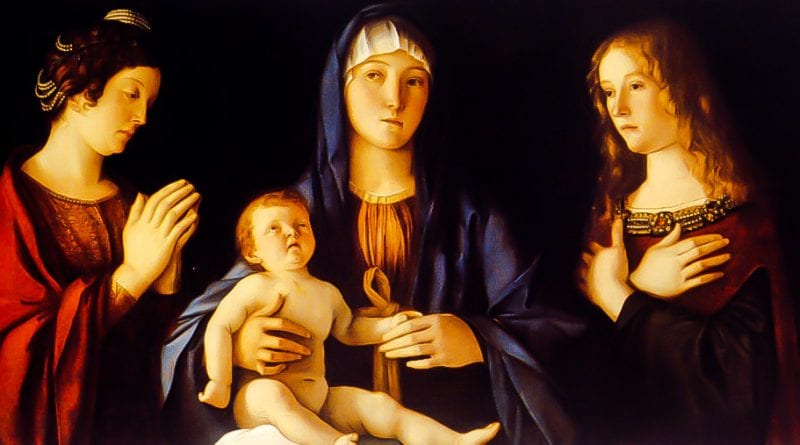

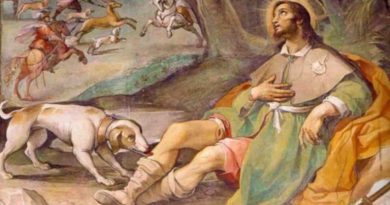


As a Catholic composer of art music working in an atonal medium (I’m currently working on a setting of the Adoration of the Cross in Latin), I fully sympathize with your situation of having to defend your choice to someone who simply doesn’t have the knowledge of the history and practices of the arts yet makes a value judgement.
I have often said, “shut your eyes and listen to God’s music; does it have a tonic-dominant tonal relationship, regular strophing, formal cadencing . . . . ” Never seems to work and the subject of the criticism continues to be vilified.
I enjoyed your defence and your choice. Bravo from one soul out there.